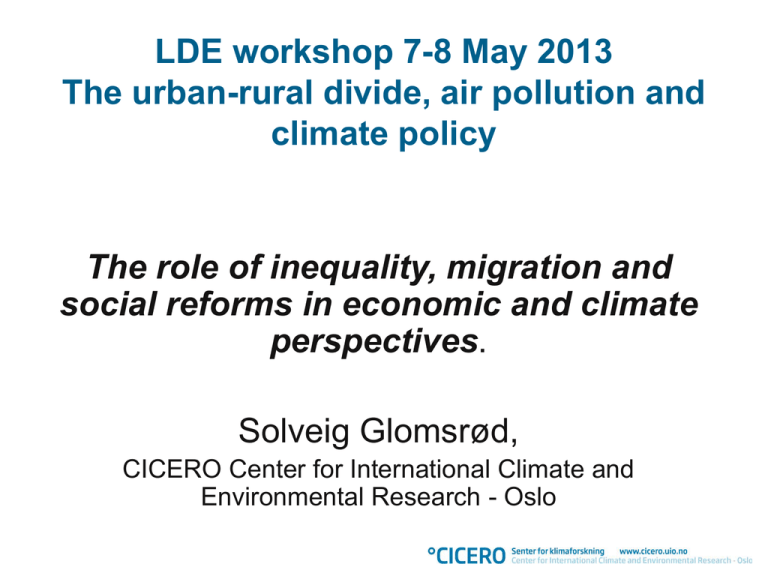LDE workshop 7-8 May 2013 The urban-rural divide, air pollution and
advertisement

LDE workshop 7-8 May 2013 The urban-rural divide, air pollution and climate policy The role of inequality, migration and social reforms in economic and climate perspectives. Solveig Glomsrød, CICERO Center for International Climate and Environmental Research - Oslo China’s Development is “Unbalanced Uncoordinated Unsustainable” 中国发展的 “不均衡、 不协调、 不可持续” 2 Imbalances • Urban-rural income gap 3.13 (in 2011) • Poverty (100 million rural people) • Investment and export driven economy • Credit market – interest rate regulated • Population growth – age structure Urban - rural income gap • In 2011 the average urban income was 3.13 times average rural income. • Urban income includes income of both registered urban residents and rural work migrants Income and population 2011, floating in urban population 250 800 700 18 600 230 Income, billion Yuan 57 500 150 400 657 100 133 300 Population, million 200 Without floating Wage, floating Others, local urban Wage, local urban Without floating Floating Local urban 461 200 50 100 46 0 0 Income population Income Population Urban Urban Rural Rural Income and population 2011, floating in rural population 200 1000 180 900 160 57 230 800 700 140 600 120 500 100 400 80 60 133 657 461 40 300 200 100 46 0 0 Income population Income Population Urban Urban Rural Rural Without floating Others, local urban Wage, local urban Floating Without floating Local urban 18 20 Population, million Income, billion Yuan Wage, floating Per capita Income level and gap 2011 35000 4.50 4.04 4.00 30000 3.50 3.13 25000 20000 2.50 2.00 15000 10000 28886 1.50 21810 1.00 5000 6977 7148 0 0.50 0.00 Floating in urban Floating in rural Income gap, urban/rural Income per capita, Yuan 3.00 Urban Rural Income gap Rural family decision tree Rural family utility ehr=0.5 Sub-utility of rural household in the village Sub-utility of rural migrants ehf=1.57 rur=1.57 Leisure Leisure Agricultural good (self-supply) Non-agricultural good Agricultural Non-agricultural good good Modeling behaviour of rural households in a CGE for China • Pilot CGE model, numerical policy experiments • Separate urban-rural economies • Rural-urban work migration • New decision tree for the rural population • Policy experiment: Increase wage rate of work migrants in the cities by 10 per cent Percentage change in total and factor income by household group. Poverty reduction and climate policy How does policies work? A carbon tax on fossil fuel • Urban sector more fossil based than the rural sector, production contracts • Reduced demand for rural labour in the cities • Rural labour return to agriculture • Increased food production • Lower food prices, reduced costs of living • Urban real wage is rising (enhancing work migration) Different consumption pattern rural –urban households Biomass production • Garlic –a seasonal crop • Follows after cotton • Cotton bushes removed to give place for garlic • Last cotton output picked in the village byold, women and children • Residues used for bioenergy • Fuel collected outside the gate Burnt in the kitchen or in the yard Particles of local and global concern • From biomass, coal and diesel motors • Damage health • Heats the atmosphere • Very short lived • Biomass burning deeply rooted in the agricultural production system. • Persistent? To sum up: • Rural labour has one foot in each of the ”economies” making the labour market and effect of policies volatile • Rural work migrants and their rural families take their decisions jointly- but have different lifestyles • Appropriate income segments - a precondition for analysis of climate policy, economic growth, and poverty.



